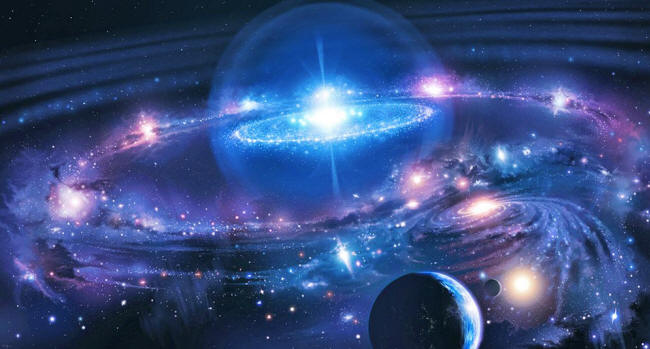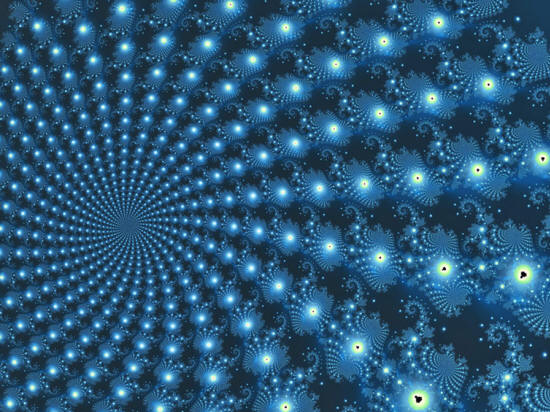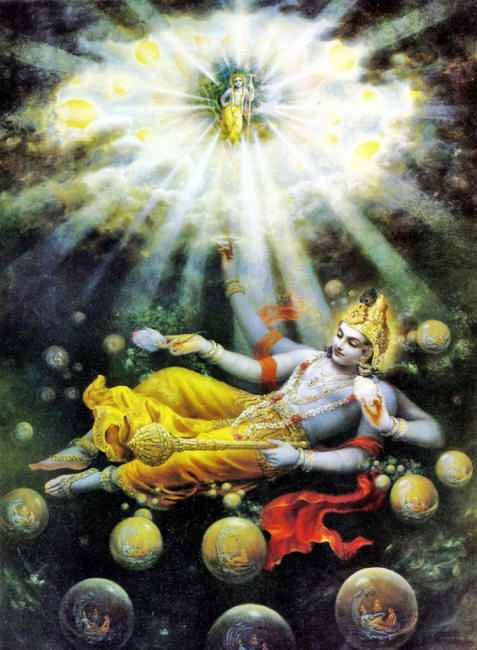Mind-blowing Secrets behind Brahma, Big
Bang and Creation of the Universe
by
Pallavi Thakur
June
2016
from
SpeakingTree Website
recovered through
WayBackMachine Website
1. So how did
life arrive on Earth?
This question
has always troubled me, how exactly did human race come to dwell
in a blue ball spinning in completely black space? Were we put
here by an architect? Did we evolve from simpler forms of life
(as science says)? Could we have migrated here from another
planet? Let's explore the diverse theories that are prevalent in
Hinduism of those earliest days…
2. The Big Bang
theory
One of the
theories put forward by cosmologists is
the Big Bang theory. This
suggests that about 15,000 million years ago there was a massive
explosion. This was the point at which all matter in the
universe began; space and time began then too. Over time the
universe that we know, and human and animal life, emerged. This
theory is generally accepted by scientists as being the best
theory they have to explain the origins of the universe.
3. Science versus
sacred texts
Most of us
have read and accepted the verdict of science - that we are the
chance result of billions of years of evolution from
single-celled creatures, to sea-born creatures, to reptiles,
birds, mammals, to apes and finally to man. But the Vedas and
Puranas have different stories to tell. Read on to know about a
few concepts that converse beyond science…
4. It all started
from Lord Vishnu
Vedas say that
before the creation of the universe Lord Vishnu is sleeping in
the ocean of all causes. His bed is a giant serpent with
thousands of cobra like hoods. While Vishnu is asleep, a lotus
sprouts of his navel (note that navel is symbolized as the root
of creation). Inside this lotus, Brahma resides. Brahma
represents the universe which we all live in, and it is this
Brahma who creates life forms.
5. The idea of
multiverse
Vishnu is the
personification of the eternal
multiverse that exists forever
without any beginning or end. Brahma is the personification of
our temporary physical universe that was created in the big
bang. Brahma is said to have been created from the navel (which
is a single point) of Vishnu, described as a lotus blooming out
of the navel, much like our big bang universe.
6. A temporary place
to be
Now this
universe represented by Brahma is not a permanent universe, it
is temporary, Brahma lives for 100 years, says the Vedas, and
then dies and then a new universe (Brahma) is born (1 year of
Brahma = 3.1104 trillion human years -
Wikipedia). So as per Vedas,
our universe lives for 100 years. Talking of time measurements -
Brahma lives for hundred years say Vedas and we are in the first
day of the 51st year of the Brahma.
7. Talking of
symbolism
For now,
Brahma represents our universe which has birth and death, a big
bang and a big crunch, from a navel singularity. Vishnu
represents the eternity that lies beyond our universe which has
no birth or death and that which is eternal! Many such universes
like ours exist in Vishnu. Vedas say that thousands of Brahmas
have passed away! In other words, this is not the first time
universe has been created.
8. The theory
involving Purusha
In the Rig
Veda (the first scripture of Hinduism, containing spiritual and
scientific knowledge) it says that the universe was created out
of the parts of the body of a single cosmic man Purusha when his
body was sacrificed. There the four classes (varnas) of Indian
society come from his body: the priest (Brahmin) from his mouth,
the warrior (Kshatritya) from his arms, the peasant (Vaishya)
from his thighs, and the servant (Shudra) from his legs.
9. As per the
Chandogya Upanishad
In the
Chandogya Upanishad it says that in the beginning was the
Brahman, and through heaven, the earth, and the atmosphere and
the three seasons of summer, rains, and harvest he produced the
entire universe.
10. Where science
meets Vedas
Some
scientists have suggested that, following the Big Bang, the
process of the expansion of the universe will eventually be
reversed and at some distant point in the future will start to
contract, eventually imploding into a 'Big
Crunch'. This could lead to another ‘Big Bang', with
a new universe being formed. This somehow relates to the present
Brahma years coming to an end.
11. Pralaya or the
Big Crunch?
A universe
endures for about 4,320,000,000 years (one day of Brahma, the
creator or Kalpa) and is then destroyed by fire or water
elements. At this point, Brahma rests for one night, just as
long as the day. This process, named Pralaya, repeats for 100
Brahma years (311 Trillion, 40 Billion Human Years) that
represents Brahma's lifespan. Brahma is regarded as a
manifestation of Brahman as the creator.
12. Another theory:
Born from OM
The universe
is often said to be born from the sacred syllable Om, or from an
inert void in which "there was neither being nor non-being...
death nor non- death", a single principle from which emerged the
diversity of life. From this void desire was born, and from
desire came humans, gods and demons.
13. The theory of The
Golden Egg
In earlier
Vedic thinking, the universe was created by Hiranyagarbha (here
interpreted as 'the golden embryo') or by Prajapati who was born
from the Hiranyagarbha (here interpreted as 'the golden womb').
Prajapati was later identified with the puranic Brahma. Other
gods are credited with acts of creation, primarily the act of
propping apart the sky and the Earth - gods who are said to have
done this include Indra, Varuna and Vishnu.
14. The theory of
zilch
According to
some school of thoughts, in Hinduism, the universe had no
beginning it was there always. As Sri Krishna said "Never was
there a time when I did not exist, nor you, nor all these kings;
nor in the future shall any of us cease to be".
15. Once there was a
man and the creator
Another
version of creation of the universe credits it to pure Self in
the form of a man, existing alone without a Creator. It looked
around and saw nothing but itself, divided itself into two parts
for company and created everything in this universe. That is why
it is said that a husband and wife are two halves of a single
being. The husband and wife had intercourse; and from their
union human beings were born.
16. As per Shaiva
Scriptures
As per Shaiva
scriptures, at first the ultimate truth "Brahman" was Shiva
without any birth or death. Vishnu is formed from the Vaamanga
of Shiva or the left body. Shiva is the extreme male power of
the universe. From him manifested the extreme female power of
the universe Sati. Then the preserver of the universe Vishnu
took three forms - MahaVishnu, Garbhodakasayivisnu and
Ksirodaksayi vishnu. Maha Visnu have several
Garbhodakasayivishnus in the spiritual sky.
17. Then came the
Brahma
Each
Garbhodakasayivishnu exhales and inhales and with each breath a
Brahma is born who lives for 100 Brahma years and dies with the
breath of Garbhodakasayi vishnu. Each Brahma creates a universe
which comes to an end with partial annihilation after several
Brahma years. And this cycle begins again.
18. As per Buddhism
Buddha taught
that this world will come to an end, but that in time a new
world will evolve again. Certain Karmas will cause souls to
again seek life in the body;
others will follow and become more and more attached to the
body, developing passion, selfishness and other 'evils'. The
Buddhist scripture Saddharma Pundarika mentions that there are
so many worlds beyond this one that no one "should be able to
imagine, weigh, count or determine their number."
19. As per Jainism
The Jains hold
that the world, souls and time are uncreated, unbeginning and
unending. The world exists through its own being and is divided
into heaven, earth and hell
20. In Christianity
Christians and
Jews believe in the making of man by God on the sixth day
of creation (some 4,000 years ago) out of clay and in His own
image, as told in the Book of Genesis. The Muslims believe,
similarly, that Allah created Adam, the first man in
Paradise, then the first woman, Hawa (Eve). There they lived a
perfect life in a perfect universe, far vaster than ours. They
were cast to Earth when they committed the first disobedience of
God, after a jealous Satan tricked them.




